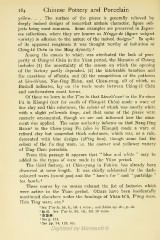Page 298 - Chinese pottery and porcelain : an account of the potter's art in China from primitive times to the present day
P. 298
164 Chinese Pottery and Porcelain
yellow. . . The surface of the pieces is generally relieved by
deeply incised designs of somewhat archaic character, figure sub-
jects being most common. Some examples are preserved in Japan-
ese collections, where they are known as Ningyo-de (figure subject
variety) in allusion to the nature of the incised designs." In spite
of its apparent roughness it was thought worthy of imitation at
Ching-te Chen in the Ming dynasty.^
Among the causes to which was attributed the lack of pros-
perity at Ching-te Chen in the Yiian period, the Memoirs of Chiang
includes (1) the uncertainty of the season on which the opening
of the factory partly depended, (2) the intolerable taxation and
the exactions of officials, and (3) the competition of the potteries
at Lin-ch'uan, Nan-feng Hsien, and Chien-yang, all of which, as
Bushell indicates, lay on the trade route between Ching-te Chen
and south-eastern coast towns.
Of these we learn in the T'ao lu that Lin-ch'uan^ in the Fu-chou
Fu in Kiangsi (not far south of Ching-te Chen) made a ware of
fine clay and thin substance, the colour of which was mostly white
with a slight yellowish tinge, and that some of the pieces were
coarsely ornamented, though we are not informed how the orna-
ment was applied. The same authority informs us that Nang-feng
Hsien^ in the Chien-yang Fu (also in Kiangsi) made a ware of
refined clay but somewhat thick substance, which was, as a rule,
decorated with blue designs {chHng hud), though some had the
colour of the fu ting ware, i.e. the coarser and yellower variety
of Ting Chou porcelain.
From this passage it appears that " blue and white " may be
added to the types of ware made in the Yiian period.
The third factory, at Chien-yang in Fukien, has already been
discussed at some length. It was chieflv celebrated for the dark-
coloured wares [wu-ni yao) and the " hare's fur " and " partridge "
tea bowls.*
These names by no means exhaust the list of factories which
were active in the Yiian period. Others have been incidentally
mentioned elsewhere under the headings of Yiian-tz'u, P'eng ware,
Hsin Ting ware, etc.^
Tao1 See lu, bk. ii., fol. 4 verso ; and Julien op. cit., p. 42.
" Eg jll- See T'ao lu, bk. vii., fol. 10 verso.
* See p. 131.
5 See pp. 94, 128, etc.

